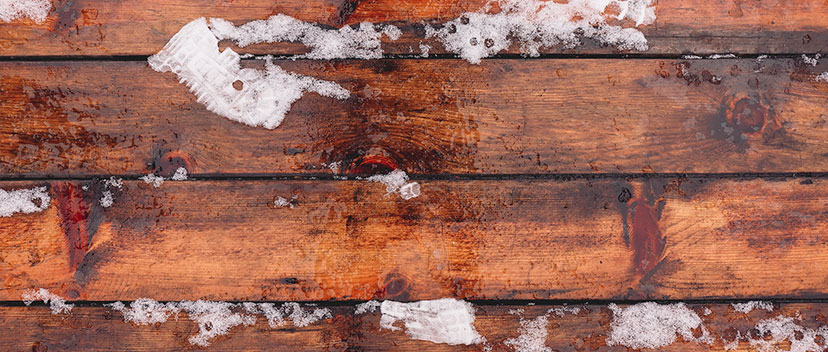The icy grip of winter has once again taken hold, causing snow, salt and slush to be tracked into your business, staining your floors and leading to irreversible damage. Aside from leaving unsightly grime and discoloration throughout your building, the byproducts of some snow and ice removal methods can cause long lasting damage to floors and other surfaces, costing your business big bucks in the long run.
Trying to thwart the continual build-up of salt and snow in your most heavily trafficked areas can feel like a pyrrhic victory, sacrificing your staff’s time and energy to fight a battle that will ultimately end in defeat. Fortunately, there are some easy-to-implement tips and tricks that can help protect your floors from the beatings of winter.
Snow and Slush Requires Diligence
Winter means one thing to most people: snow. Once the white stuff blankets sidewalks and streets, it inevitably sticks to boots, clothing and just about anything else it falls on. Once snow starts to melt or is tread on enough, it becomes slush, a carrier of dirt and moisture.
Aside from exterior clearing and management of snow accumulation, the internal depositing of snow in high traffic areas—such as vestibules, doorways and lobbies—can be a safety hazard to employees and visitors if not monitored and mitigated. From 2010-2015, falls were the leading cause of unintentional injury, with over 54 million non-fatal falls landing people in hospitals across the country1.
To prevent your staff and customers from becoming another statistic, there are a few steps your business can take to reduce the tracking in of snow and slush:
- Provide mats and shoe scraping stations at entrances to your business
- Employ or conduct diligent exterior snow removal
- Contain and eliminate any snow or slush brought in ASAP
Entrance mats and boot scrapers not only allow customers and staff to remove snow and slush from their shoes and boots, but it also projects an expectation to anyone entering your business, “please clean your shoes before entering”. Consistent external snow removal is also key; by keeping main external pathways to and from your business clear of snow and slush, the less there will be to get tracked in when someone enters your building.
By keeping tabs on heavy traffic areas, cleaning staff can periodically keep snow, slush and subsequent melt water to a minimum, making your business a safer, more sanitary place.
Salt Melt Can Be Harmful If Left Untreated
Salt melt is one of the most widely implemented tactics to accelerate the melting of snow and ice; over 15 million tons are dumped on our sidewalks and roads every year2. With that staggeringly large application comes subsequently high damage costs; salt melt is estimated to cause $5 billion of damage to roads, sidewalks and additional infrastructure that it’s applied to. Salt melt is corrosive, so in addition to the ridding of snow and ice by lowering its melting point, it also eats holes in roads, concrete and rusts the undercarriages of cars.
With all the damage that salt melt causes to roadways and vehicles, it’s no wonder that it’s one of the most detrimental elements to introduce to your business’s floors. The tracking of salt onto carpets can cause massive, unsightly white stains that are difficult to remove without the help of a professional commercial cleaning company. Wooden floors are even worse; salt melt’s corrosive nature means that moisture from snow or slush will seep into wooden floors, causing deterioration and warping.
A Simple Solution
Luckily, there’s a fairly easy solution to small, controlled areas of your floor that have been exposed to salt melt; water and white vinegar. Making a solution comprised of half warm water and half white vinegar is an effective cleaning agent for salt melt floor cleaning. Apply the mixture to an affected area and gently scrub with a brush and dab the area with a dry towel to absorb the salt that’s been driven out of the carpet.
For wooden floors, dilute a cup of white vinegar in a gallon of water and clean as you normally would. The white vinegar will eliminate salt residue stains and help reduce the absorption of harmful salt into wooden floors.
For large areas of floor space that are subject to heavy traffic, it may be best to hire a professional cleaning company. Cleaning companies use granular based floor conditioners and neutralizers to combat the constant threat of salt melt stains and water buildup residue. A professional service will not only use specialized products or techniques to alleviate the effects of salt melt on your business’s hardwood or carpeted flooring, but can also:
- Provide guaranteed support and satisfaction
- Use innovative technology for sensitive surfaces
- Hold the cleanliness of your floors to higher standards
- Prioritize health and safety with green cleaning products
- Manage their team to ensure punctuality and building security


One thought on “Salt Melt and Snow Removal: How To Clean Your Floors During The Winter”
Comments are closed.